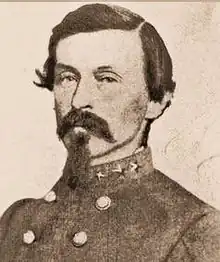Robert Alexander Caskie
Robert Alexander Caskie (1829/30 – August 31, 1928) was a Virginian officer in the Confederate States Army during the American Civil War.
Robert A. Caskie | |
|---|---|
 | |
| Died | August 31, 1928 (aged 98) Philadelphia, Pennsylvania, US |
| Allegiance | |
| Branch | |
| Rank | |
| Battles | |
Life

Robert Alexander Caskie, son of John Caskie, Esq., of Richmond, Virginia, and latterly of Missouri,[1] was a descendant of one of the oldest families of Virginia.[2] During the Civil War he was an officer in the Richmond Grays and the organizer and leader of the Caskie Rangers, a band of cavalry.[2] Later he became liaison officer, serving Generals Lee, Jackson and Stuart.[2] He fought in many battles and once was seriously wounded.[2]
Caskie died on August 31, 1928, at the home of his son, John J. Kerr Caskie, in Merion, a suburb of Philadelphia.[2] He was ninety-eight years old.[2]
Personal life
In 1859 Colonel Caskie was married to Amanda Wallace Gregory, daughter of Judge Munford Gregory, sometime Governor of Virginia.[3] His wife died several years before him.[3] Two daughters, Mrs. M. C. Plass, of Washington, and Mrs. A. C. Thomas, of Paris, France, and two sons survived him.[3] One son, John J. K. Caskie, became general counsel of the Philadelphia Rapid Transit Company.[3] Edmund W. Caskie, the other son, was a resident of New York.[3]
References
- Lewis; Brock 1888, i. p. 203.
- St. Louis Post-Dispatch. Aug. 31, 1928. p. 3.
- Daily Press. Sep. 1, 1928. p. 1.
Sources
- Lewis, Virgil A.; Brock, R. A. (1888). Virginia and Virginians: Eminent Virginians. Vol. 1. Richmond and Toledo: H. H. Hardesty. p. 203.
- "Aged Confederate Veteran Is Dead". Daily Press (Newport News, Virginia). September 1, 1928. p. 1.
- "Col. Robert A. Caskie Dies". St. Louis Post-Dispatch. August 31, 1928. p. 3.
Further reading
- Garnett, Theodore Stanford (1994). Trout, Robert J. (ed.). Riding with Stuart: Reminiscences of an Aide-de-Camp. United States: White Maine Publishing Co., Inc. pp. 78–79.